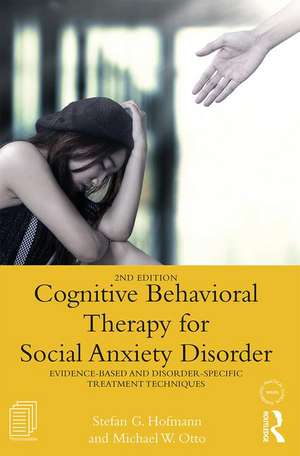Cognitive Behavioral Therapy for Social Anxiety Disorder: Evidence-Based and Disorder Specific Treatment Techniques: Practical Clinical Guidebooks
Autor Stefan G. Hofmann, Michael W. Ottoen Limba Engleză Paperback – 18 dec 2017
Cognitive Behavioral Therapy (CBT) has proven to be the most effective form of treatment for social anxiety disorder. This revision of a highly regarded treatment manual presents an original treatment approach that includes specifically designed interventions to strengthen the relevant CBT strategies. This extensively revised volume builds upon empirical research to address the psychopathology and heterogeneity of social anxiety disorder, creating a series of specific interventions with numerous case examples and four new chapters on working with patients on medication, cultural factors, individual therapy, and monitoring on-track outcomes.
| Toate formatele și edițiile | Preț | Express |
|---|---|---|
| Paperback (1) | 273.02 lei 6-8 săpt. | |
| Taylor & Francis – 18 dec 2017 | 273.02 lei 6-8 săpt. | |
| Hardback (1) | 1093.95 lei 6-8 săpt. | |
| Taylor & Francis – 19 dec 2017 | 1093.95 lei 6-8 săpt. |
Preț: 273.02 lei
Preț vechi: 287.39 lei
-5% Nou
52.26€ • 56.78$ • 43.93£
Carte tipărită la comandă
Livrare economică 22 aprilie-06 mai
Specificații
ISBN-10: 1138671436
Pagini: 224
Ilustrații: 18 Tables, black and white; 11 Line drawings, black and white
Dimensiuni: 152 x 229 x 12 mm
Greutate: 0.32 kg
Ediția:2nd edition
Editura: Taylor & Francis
Colecția Routledge
Seria Practical Clinical Guidebooks
Locul publicării:Oxford, United Kingdom
Public țintă
Professional and Professional Practice & DevelopmentCuprins
Table of Contents
Chapter 1: Characterizing Social Anxiety Disorder
What is Social Anxiety Disorder?
Diagnostic Criteria for SAD
Disorder Prevalence and Characteristics
Information Processing of SAD
Etiology of SAD
Assessment of Social Anxiety and SAD
Contemporary Psychological Treatments
Pharmacological Treatments
Chapter 2: Overall Description of Treatment Strategy
Just do it!
The General Treatment Model
The Elements of the Treatment Model
Putting It All Together: Designing Exposures
Chapter 3: Research Basis for the Treatment Model
Social Standards
Goal Setting
Self-Focused Attention
Self-Perception
Estimated Social Cost
Perception of Emotional Control
Perceived Social Skills
Safety and Avoidance Behaviors
Post-Event Rumination
Summary
Chapter 4: Session-by-Session Outline
General Outline
Session 1
Session 2
Session 3-6
Session 7-End
Last Session
Chapter 5: Treatment Modifications and Considerations
Individual Treatment Modifications
Working with Patients on Medication
Chapter 6: Treatment in Action: Clinical Examples
Preparation for Exposures
Early In-Session Exposures with Attention Training
Post-Exposure Discussion
Viewing Videotaped Exposures
Home Practice Exposures
Later In-Session Exposures
In-Vivo Social Mishap Exposures
Chapter 7: Complicating Factors
Intrusive and Self-Deprecating Thoughts
Hostility and paranoia
Depression and SAD
Substance Abuse and SAD
Troubleshooting: Nonresponse
Trouble Shooting: Poor Adherence
Troubleshooting: Poor Retention of Therapeutic Gains
Chapter 8: Maintenance and Follow-Up Strategies
Generalizing Treatment Skills
Relapse Prevention Skills
Closing Treatment: Attending to Well-Being
Booster Sessions
Chapter 9: Cultural Factors
Cultural Differences in Prevalence Rates
Cultural Differences in Treatment Response
Cultural-Specific Expressions of SAD
Dimensions Contributing to Cultural Differences
Summary
Notă biografică
Stefan G. Hofmann, PhD is a professor of psychology at Boston University, editor of Cognitive Therapy and Research, and a highly cited researcher with more than 300 peer-reviewed journal articles and 20 books on the nature and treatment of emotional disorders.
Michael W. Otto, PhD is a professor of psychology at Boston University. His work includes over 400 publications on the nature and treatment of anxiety, mood, and substance use disorders.
Recenzii
“I recommend publishing this book for the reasons outlined above. The authors are leaders in CBT and have developed a text that is based on the latest research while keeping in mind that patients present differently, thus requiring an intervention that meets their needs and preferences. How to refine CBT applications to best work with patients to help them achieve their goals is what this book is all about.”—Jasper Smits, PhD, professor of psychology, U Texas at Austin.
This book, written by two of the leading clinician-scientists in the field of anxiety disorders, is a thoughtfully revised and updated version of what was already a go-to manual for practitioners wanting to provide state-of-the-art care for their patients with social anxiety disorder (SAD). It provides clear, step-by-step guidance on utilizing cognitive-behavioral interventions for SAD, and effectively embeds case examples throughout to underscore and emphasize key principles for their employment. This is a very valuable book for both the trainee wanting practical guidance as they seek to master the practice of CBT as well as for the seasoned clinician looking to sharpen their practice.
Mark H. Pollack, M.D., The Grainger Professor and Chairman, Department of Psychiatry, Rush University Medical Center, Past President, Anxiety and Depression Association of America
Hofmann and Otto, with groundbreaking research paving the way, have produced an easy to use but powerful and cutting-edge program for treating the devastations of social anxiety disorder that should be on every clinician’s bookshelf. Their decades of hands-on experience with this difficult problem and their compassion for those suffering from it are evident.
David H. Barlow Ph.D, ABPP, Professor of Psychology and Psychiatry, Founder and Director Emeritus, Center for Anxiety and Related Disorders at Boston University







